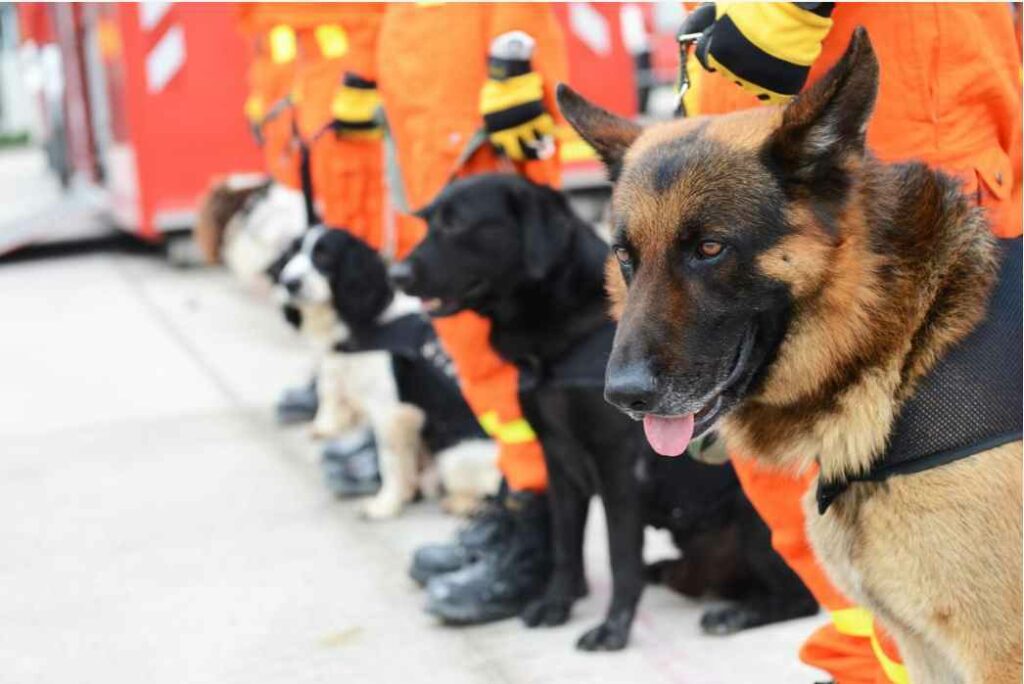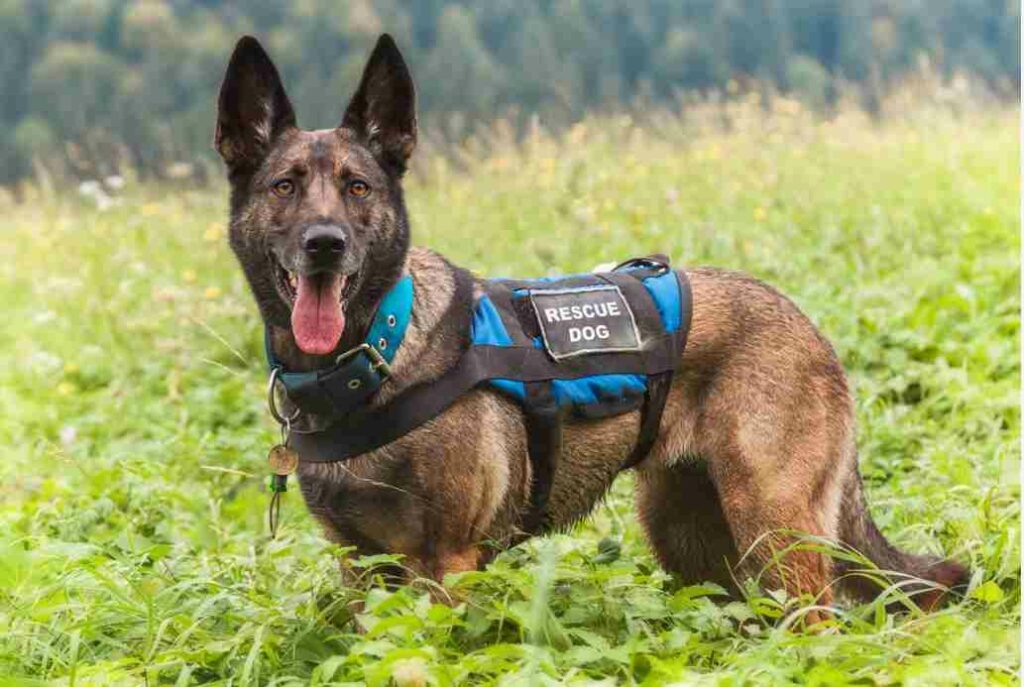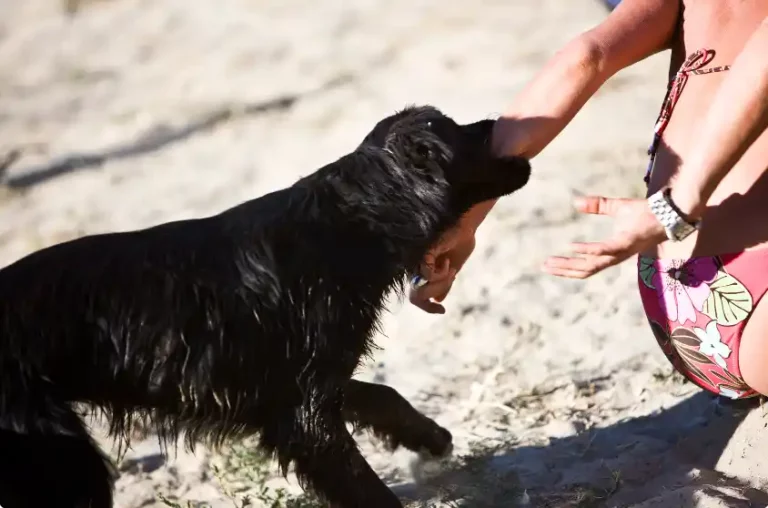The Lifesaving Power of Search and Rescue Dogs (SAR)
Search and rescue (SAR) dogs are four-legged heroes who save lives daily. More than 300 specially-trained canines across the U.S. are ready to be deployed immediately when disasters strike. Labrador Retrievers, German Shepherds, and Belgian Malinois are the most popular breeds for SAR work, making up 45%, 32%, and 10% of working dogs, respectively.
SAR dogs and their handlers undergo rigorous training to prepare them for any situation. At 8-10 weeks old, puppies begin basic obedience and socialization. Once mature at 1-2 years old, they progress to complex scent training and simulated search exercises. A SAR dog is not certified for field work until completing 200-300 hours of instruction over 12-18 months.

When catastrophes occur, SAR dogs are first on site, ready to utilize their sharp senses and determination. Equipped with durable K9 boots and harnesses, these canines can search for up to 10 hours nonstop. Their most valuable asset is their acute sense of smell, capable of detecting odors at concentrations as low as 1 part per trillion. In the rubble of 9/11, SAR dogs located survivors buried 30 feet below ground. Each year, they contribute to saving around 25,000 lives.
The unwavering dedication between SAR dogs and handlers creates a powerful bond. Together, they form an unstoppable lifesaving team that brings hope during life’s darkest hours. Their service proves that a man’s best friend is still a dog.
Table of Contents
- Definition of a search and rescue dog
- Search and Rescue Dog Basics
- History of SAR Dogs
- The Top Breeds for Search and Rescue Duty
- How do SAR dogs help?
- Four Fields of SAR Dog Training
- Diverse SAR Duties
- Earning the SAR Dog Certification – SAR dog certification standards
- Search and Rescue Dog Training Basics
- SAR Dog Handler Training
- Private SAR Dog Training
- Getting Started in SAR Dog Training
- SAR Dog Training Essentials
- SAR Dogs Saving Lives in Disasters
- Life After Duty for SAR Dogs
- Getting Your Own SAR Dog
- Conclusion
Definition of a search and rescue dog
Search and rescue (SAR) dogs are specially trained canines that assist in finding missing persons or bodies during disasters, accidents, or criminal incidents. They work closely with SAR handlers who direct and interpret the dog’s signals and behaviors during search operations.
To become a certified SAR, dog breeds like Labrador Retrievers and German Shepherds undergo extensive training from 8-10 weeks old. This includes basic obedience, scent detection, navigation, agility, and simulated search exercises, which take 1-2 years and 200-300 hours to complete.
The rigorous training allows SAR dogs to hone their excellent sense of smell and their ability to search tirelessly for up to 10 hours. Their skills are tested in real-life situations like earthquakes, floods, avalanches, and building collapses to locate survivors or recover remains. The powerful bond between SAR dogs and their handlers makes them an invaluable search unit that saves lives.
Here are some critical facts about search and rescue dogs.
Search and Rescue Dog Basics
Search and rescue (SAR) dogs must have an independent yet obedient temperament to do their job well. The dog and human handler require stamina, determination, and training to work in difficult search conditions.
As natural hunters, dogs can be taught to search methodically for long periods. With proper direction from their handler, SAR dogs will work tirelessly to complete a search, leveraging their exceptional sense of smell.
SAR dogs are trained in two primary techniques – air scenting and trailing. Air scenting involves detecting human scent particles drifting through the air to locate the person. Trailing requires following ground disturbances and the person’s scent path to find them. By combining air scenting and trailing, SAR dog teams can effectively search large, complex environments like avalanche debris or earthquake wreckage. Their perseverance and scenting abilities lead to high success rates.
Forming a close working bond between the handler and the SAR dog is crucial for interpreting signals and communicating during high-stress operations. This allows them to utilize their strengths and save lives. Below is a summary of the history of search and rescue (SAR) dogs.
History of SAR Dogs
The earliest recorded use of SAR dogs was in the 1800s by monks and their St. Bernard dogs to locate travelers buried in snow on the Great St. Bernard Pass in the Swiss Alps.

In 1988, SAR dog teams from around the world assisted in locating victims trapped in collapsed buildings after an earthquake in Armenia. This led the International Search and Rescue Dog Organization (IRO) to coordinate global SAR dog efforts.
The IRO, founded in 1989, now consists of over 108 SAR dog organizations worldwide that train and deploy SAR dogs to disasters.
Since 2008, the last Sunday of April is annually celebrated as International SAR Dog Day to honor SAR dogs and handlers. It features seminars, demonstrations, and training exercises.
Major SAR dog deployments include the 1995 Oklahoma City bombing, the 2001 9/11 attacks, the 2010 Haiti earthquake, and the 2020 Beirut explosion. Their lifesaving contributions are invaluable.
Ongoing events and SAR dog news are shared on the IRO website and social media to showcase these canine heroes’ hard work and bravery.
The Top Breeds for Search and Rescue Duty
Search and rescue (SAR) dogs come from breeds with strong “hunting instincts, high energy, intelligence, and excellent scenting abilities”.
The most popular species making up SAR teams in the U.S. are,
- Labrador Retrievers (45%) – America’s #1 dog breed. Their temperament, agility, and love of water make Labs ideal for wilderness, avalanche, and drowning victims.
- German Shepherds (32%) – The 2nd most common SAR dog. Revered for their trainability, fearlessness, and endurance during demanding searches.
- Belgian Malinois (10%) – An intelligent Belgian herding breed valued for their energetic, independent thinking during complex missions.
- Bloodhounds – Unrivaled tracking ability thanks to their 230 million scent receptors and loose skin that stir smells near the ground.
- Coonhounds – The ultimate blend of speed, stamina, agility, and determination to search rough terrain for long periods.
- Beagles – Friendly companions sized right to search小areas for missing children and comfort them once found.
- St. Bernards – Legendary alpine rescue dogs can locate buried avalanche victims with keen cold-weather scenting.
- Australian Shepherds – Tireless herders that use their smarts and high energy to cover expansive search areas.
- Newfoundlands – Historically served as water rescue and messenger dogs. Excellent swimmers able to work in frigid water.
- Spaniels – People-oriented dogs like Springer Spaniels are eager to please handlers during demanding missions.
- Pointers – Follow scents energetically for miles thanks to generations of tracking hunted game birds.
With training and experience, most breeds can contribute to search efforts by leveraging their strengths. But historically, it’s the hounds, shepherds, and retrievers on the front lines saving lives with their heroic efforts.
How do SAR dogs help?
Search and rescue (SAR) dogs perform lifesaving work alongside trained human handlers.

Their essential duties include,
- Methodical searching over large areas – SAR dogs are trained to search assigned areas systematically using either a grid pattern or direction from their handler.
- Scent detection – Using their exceptional sense of smell, SAR dogs can detect human scent from great distances. This allows them to pinpoint potential victims.
- Trailing – SAR dogs can follow a specific person’s ground scent path for miles to locate them. Using their nose close to the ground, they track disturbances in vegetation and odors.
- Alerting – Once SAR dogs detect a person or remains, they are trained to alert their handler by barking, sitting, or staring intently. This communication is critical for rescue operations.
- Comforting – SAR dogs help calm anxious victims who may be disoriented or injured after being located. Their presence provides reassurance.
With their determination and advanced scenting abilities, SAR dogs play a vital role in search operations. Their tracking, trailing, air-scenting, alerting, and comforting skills make them invaluable partners for locating and aiding survivors.
Four Fields of SAR Dog Training
- Tracking –
Tracking dogs are trained to find and follow a specific person’s ground scent using their nose close to the ground. They detect crushed vegetation and odors left behind from footsteps and touch.
- Trailing –
Trailing dogs are trained to follow a person’s ground scent path for long distances, even when the trail is intermittently broken. They use air currents to relocate the scent.
- Air scent –
Air-scenting dogs search for human scent carried on air currents. Once detected, they follow the scent to its source, which may be far away, horizontally or vertically.
- Human remains detection –
Human remains detection dogs search for deceased victims. Training sensitizes them to detect specific scent chemicals released during tissue decomposition.
SAR dogs begin gradual, positive reinforcement training as early as 8-12 weeks old. Each dog progresses at its own pace through the 600+ hour certification process, including obedience, agility, rescue scenarios, and field testing.
Handlers train dogs in one or more specialties based on their strengths, motivation, and breed abilities. This allows the SAR dog to maximize its scenting talents during search operations and save lives.
Here are some key details about search and rescue tracking dogs.
SAR Tracking Dogs
Tracking dogs undergo specialized training to follow the unique ground scent trail left behind by a person’s footsteps and physical contact. They keep their nose close to the ground, detecting crushed vegetation and odors adhered to the earth. Tracking dogs will periodically lift their heads to pick up airborne scent particles.

Skilled tracking dogs can accurately follow scent trails over a month old. However, a trail’s age and environmental conditions impact the strength and detectability of remaining odors.
During training, tracking dogs are taught to focus intently on one specific person’s scent and follow it to the source, ignoring distractions. This develops their scent discrimination and trailing stamina. The ability to track old, intermittent, or recently contaminated trails makes tracking dogs valuable for locating missing persons in complex search areas. Their scent-tracking focus provides crucial clues for rescue.
Breeds like “Bloodhounds, Beagles, and German Shepherds” are often chosen for their scenting prowess and determination to follow a trail to the end, no matter how far.
SAR Trailing Dogs
- Trailing dogs are specially trained to follow the ground scent path left behind by a specific missing person, even when the trail is not continuous.
- They detect the person’s odor as it is carried on air currents, allowing them to reacquire the trail after gaps in the scent path.
- Trailing dogs can accurately track a person’s meandering trail and determine if/when they double back or change direction. Their focus stays on the individual’s scent.
- These dogs typically work on leash, closely reading scent clues on the ground and air scenting. The handler follows the dog’s lead during the search.
- The ability to relocate an intermittent trail makes trailing dogs well-suited for searching urban disaster sites or following old trails across varied terrain.
- Breeds like Bloodhounds and Labrador Retrievers are often chosen for trailing since they can detect diluted scents and are highly motivated to follow a trail to its conclusion.
Now, let’s find key details about air-scent search and rescue dogs.
SAR Air-Scent Dogs
Air-scent dogs are trained to locate people by following their scent particles that have diffused into the air and environment. Working off-leash, air-scent dogs sweep search areas methodically using scent cones to detect human odor. Once found, they follow air currents to the scent’s origin.
These dogs can cover expansive search zones rapidly, leveraging air flow to travel long distances toward even faint scents. Air-scent dogs are valued for their ability to pinpoint scent sources that may be far away horizontally or vertically, like in avalanches.
Once the scent origin is located, air-scent dogs are trained to alert their handler by barking intensely and staring at the discovery site. Breeds with high energy and stamina, like German Shepherds and Border Collies, excel at wide-area air scenting thanks to their focus and determination.
The diverse search and rescue duties dogs perform.
Diverse SAR Duties

- In disaster sites, air-scent and trailing dogs often work together – air-scent dogs rapidly locate scents, and trailing dogs follow specific scent paths outward from there.
- Human remains detection dogs have specialized training to detect scent chemicals released by diseased tissue. This helps locate victims.
- Water search and rescue dogs use scenting skills to find and save drowning victims. Breeds like Newfoundlands can work tirelessly in water.
- For avalanches, agile mountain dogs like St. Bernards are critical for finding buried skiers in deep snow by scent and sound.
- On high-altitude passes, local SAR teams and dogs acclimatized to high elevations work effectively despite thin air.
- After events like tsunamis, international SAR teams are coordinated to search blocked debris fields and locate victims.
- Dogs search collapsed buildings methodically in urban disasters to pinpoint scent sources and alert teams.
- For missing persons, cadaver dogs may locate remains underground by detecting decomposition odors.
- Wilderness SAR requires fit, motivated breeds to cover vast areas. Missions often last 8+ hours over rough terrain.
- Police dogs assist in evidence collection at crime scenes by using scenting skills to uncover critical clues.
With extensive training and experience in diverse environments and tasks, SAR dogs utilize their unique talents to save lives in any situation.
Earning the SAR Dog Certification – SAR dog certification standards
Becoming a certified search and rescue (SAR) dog is an intensive process that requires extensive training and testing to rigorous standards set by the International Search and Rescue Dog Organization (IRO).
The IRO developed a certification to recognize capable SAR dogs and handlers worldwide and promote best practices. Certification involves a multi-step process spanning 12-18 months:
Step 1: Preliminary Training (8 weeks – 6 months)
- Puppies begin socialization and basic obedience as early as 8 weeks old. This initial training develops critical focus and control.
Step 2: Core Skills Training (6 months – 1 year)
- Dogs progress to scent detection, agility, navigation, and other core skills over hundreds of hours. Real-life search scenarios are introduced.
Step 3: Advanced Training (6 months – 1 year)
- Complex training in operational environments improves specialized abilities in tracking, trailing, air scenting, water search, or disaster sites.
Step 4: Skills Assessment
- Handlers demonstrate the dog’s competencies in simulated searches. Skills like alerting, agility, and scent discrimination are evaluated.
Step 5: Field Certification
- Final certification testing involves actual search operations monitored by IRO judges. Dogs must pass in their primary discipline to earn credentials.
Step 6: Ongoing Training and Assessment
- Annual re-certification is required to ensure SAR dogs and handlers maintain proficiency through regular training and fieldwork.
Earning IRO certification validates a SAR dog’s training, abilities, and commitment to saving lives. Only the most dedicated K9 heroes make it through the rigorous 200-300-hour process to become certified for lifesaving duty.
Search and Rescue Dog Training Basics

- SAR dog training starts with basic obedience, like commands and leash skills, and focuses on building communication and control.
- Handlers can connect with local SAR organizations to find training opportunities and dogs, with or without their dog initially.
- SAR certification involves passing a national exam demonstrating scenting, agility, alerting, and other abilities – dogs must be over 18 months old.
- Teams must re-certify through testing every 3 years to maintain their credentials and response readiness.
- FEMA-accredited courses prepare handlers and dogs for real search missions, assisting local and state officials when disasters strike.
- With curiosity and obedience, many breeds can become SAR dogs, but training from a young age is key to developing their potential.
- Patience and persistence through the 200+ hours of training create an incredible life-saving bond between SAR dogs and handlers.
SAR Dog Handler Training
- Handlers must develop search strategizing, navigation, briefing, and debriefing skills for search missions.
- Canine handling skills are tested – handlers must demonstrate strong communication and interpretation of their dog’s alerts and behaviors.
- Before formal training, handlers can volunteer with local SAR teams to observe real operations and learn techniques.
- To gain qualifications, handlers should pursue professional courses covering SAR fundamentals, management, and field training.
- FEMA and other accredited programs prepare handlers with 120-180 hours of classroom and field practice over 9-12 months.
- Handlers train extensively with their assigned SAR dog, focusing on obedience, scent work, agility, rescue simulations, and more.
- Testing involves staged search scenarios where experts evaluate the handler’s abilities to manage a SAR dog and its environment.
- Ongoing training and field experience develop a cohesive working relationship between SAR dogs and handlers.
With dedication and practice, SAR handlers gain the skills to direct trained SAR dogs and maximize their lifesaving potential.
Private SAR Dog Training
- The AKC offers “Urban SAR Dog” and “Wilderness SAR Dog” title certificates for dogs that complete certified training and participate in real SAR operations.
- Dogs must be proven deployable for a Wilderness SAR title and assist in at least 5 wilderness searches. Urban SAR titles require FEMA or state SAR certification.
- Private training programs offer preparation in specialties like urban disaster sites, air scenting, tracking, human remains detection, and water search and rescue.
- Group training classes are recommended to socialize SAR dogs. This builds confidence and friendliness for working around strangers during missions.
- With professional private training tailored to their needs, SAR dog teams can pass certification testing more readily after hundreds of practice hours.
- Ongoing training maintains SAR dogs’ skills and prepares handlers to direct their dogs effectively as they work together to save lives.
- Motivated owners can get started with AKC SAR titles or FEMA courses. With diligence, any breed can achieve SAR dog status and make a difference.
Getting Started in SAR Dog Training
- Research training programs and SAR teams in your local area. Many organizations hold open events where you can meet handlers and dogs.
- Attend demonstrations to see SAR dogs in action and learn first-hand about their abilities and training from experts.
- SAR dogs typically begin formal training between 1-2 years old once they have maturity and focus. Most retire from fieldwork around age 5 due to the demands.
- Reach out to SAR groups for handler training opportunities. You can start as a volunteer to gain experience before being paired with a SAR dog.
- Work on basic obedience with your dog through classes and home training to develop desirable SAR qualities like focus, drive, and agility.
- Consider fostering a SAR dog in training to contribute to their socialization and get hands-on mentoring from the organization.
- Train frequently in simulated search scenarios and various environments to build skills in tracking, air scenting, and handling techniques.
- Attend seminars and conferences to expand your knowledge of best practices in the SAR field as you progress.
With dedication and practice, you and your dog can gain the expertise to someday serve together on a life-saving SAR team.
SAR Dog Training Essentials
- Bonding between SAR dogs and handlers is crucial. Dogs must be able to focus and work independently if the handler is briefly out of sight.
- Obedience to both their primary handler and other team handlers is emphasized through distractions.
- Core commands like “Find it,” “Leave it,” “Over,” “Show me,” and “Tunnel” teach essential search, alerting, agility, and handling skills.
- Scent detection work starts with simple hides, eventually progressing to complex environments with aged scents to test dogs’ smelling capabilities.
- Realistic search scenarios prepare dogs to methodically scan disaster sites, wilderness, or buildings for human scents.
- Repeated training in challenging terrain, weather, elevations, and water conditions ensures SAR dog stamina and resilience.
- Socializing SAR dogs thoroughly is key so they can work around strangers, crowds, machinery, and chaos during deployments.
- Annual re-certifications test abilities and ensure SAR dogs retain skills through regular training between missions.
The extensive training transforms obedient dogs with strong hunt drives into dedicated heroes who effectively locate missing persons during grueling searches.
SAR Dogs Saving Lives in Disasters
After extensive training, SAR dogs put their skills to use during crises when lives hang in the balance. Specialized teams can deploy internationally to assist neighboring regions.

- For large-scale disasters, SAR dogs are called upon in the initial days for wide-area human remains detection. Their scent helps recover and identify victims.
9/11 and the WTC Attacks
- Over 300 SAR dogs participated in search efforts at Ground Zero after 9/11. The first team arrived within 15 minutes of the WTC collapse.
- Dogs located the last rescued survivor after an exhaustive 27 hours of work. Their tireless efforts brought hope in tragedy.
2010 Haiti Earthquake
- A catastrophic 7.0 earthquake devastated Haiti’s capital. SAR dogs found people alive, buried under rubble for up to 70 hours after deploying.
- Teams searched diligently amidst aftershock risks and rugged terrain during grueling 12-hour rotational shifts.
2011 Japan Tsunami
- Following the tsunami, 50 international SAR teams were coordinated to aid Japan, including 6 canine units from the U.S.
- Despite massive debris fields, these highly skilled disaster search dogs helped rescue 12 victims and supported exhausted local crews.
Here are some details about retirement for search and rescue dogs.
Life After Duty for SAR Dogs
- Most SAR dogs retire after around 4 years of active service due to the demanding physical nature of the work.
- Retired SAR dogs often stay with their handlers as beloved family pets. Their bonds, after years of life-saving service, are unbreakable.
- Otherwise, new families may adopt SAR dogs once they leave active duty. Their training makes them great companions.
- Adopting a former working SAR dog is a beautiful way to provide them a loving home after their heroic careers.
- Organizations like Pets for Patriots and Mission K9 Rescue specifically help match retired military and SAR dogs with new owners.
- Bretagne, a SAR dog who assisted at Ground Zero after 9/11, lived happily with her handler for 16 years after retirement until passing at age 16.
- In their retirement, these four-legged heroes transition from saving lives daily to enjoying the comfortable home life they deserve after years of selfless duty.
Getting Your Own SAR Dog
- Consider your local climate and terrain to choose a breed that suits your operational environment. Endurance and resilience are essential.
- Seek younger dogs under 2 years old that can handle years of demanding SAR work after training. Their working lifespan will be longer.
- Look for puppies that actively explore new things and engage with strangers. This confidence indicates SAR aptitude.
- Daily “search” games and exercise are crucial to develop scenting drive and physical stamina for SAR duty.
- Acquire from reputable breeders selecting dogs from proven working lines with inherent drives and temperaments.
- Expect costs upwards of $2,000+ for dogs from the top SAR breeds. Purebred puppies with strong pedigree are investments.
- Adopting trainee washouts or puppies from SAR handlers can offer more affordable options for finding a dog.
- Patience and dedication to proper training will allow you to mold even shelter rescues into successful SAR dogs with time.
puppiesdiary.com
Conclusion
There are a lot of dog breeds currently working as SAR dogs. They help to find people and rescue people in any emergency.
Training dogs as SAR dogs is not an easy task. It takes some time, and you must spend money with some patients.
Before buying a dog, you need to verify whether the dog breed is eligible for SAR training. Some dog breeds do not qualify as search and rescue dogs.


![Can You Leave Newborn Puppies Alone With Their Mom? [Vet Advice] 9 Can You Leave Newborn Puppies Alone With Their Mom? [Vet Advice]](https://www.puppiesdiary.com/wp-content/uploads/2023/01/Can-You-Leave-Newborn-Puppies-Alone-With-Their-Mom.webp)
![Can You Wash Your Pet With Laundry Detergent [Read Vet advice] 10 Can You Wash Your Pet With Laundry Detergent [Read Vet advice]](https://www.puppiesdiary.com/wp-content/uploads/2023/01/Can-You-Wash-Your-Pet-With-Laundry-Detergent.webp)


![Facts Of Earthdog Breeds Training, Trails And Test [Expert Advice] 13 Facts Of Earthdog Breeds Training, Trails And Test [Expert Advice]](https://www.puppiesdiary.com/wp-content/uploads/2023/11/Earthdog-Breeds-Training-768x505.jpg)